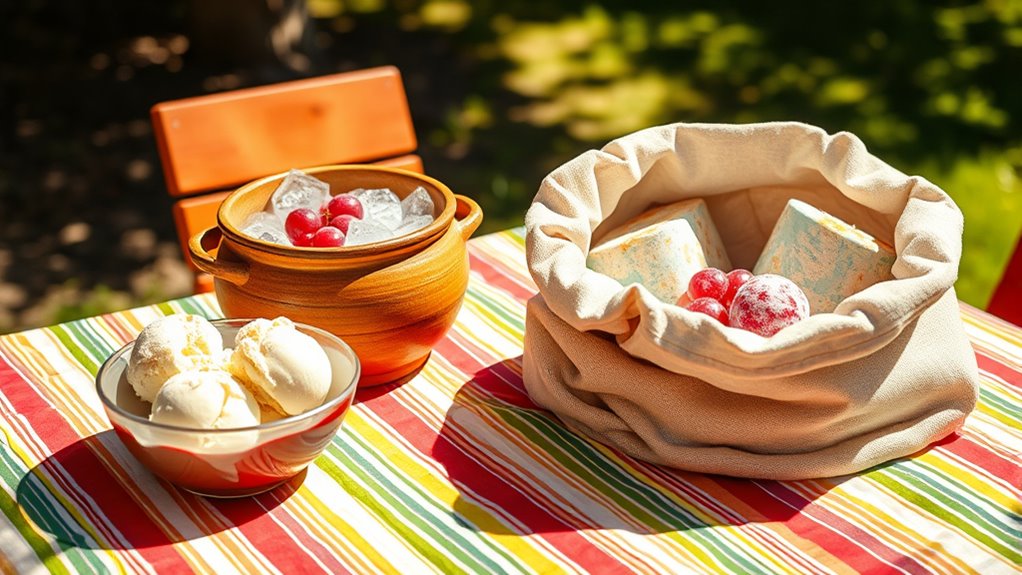If you have no freezer, you can still keep ice cream cold by using insulated containers like coolers with thick walls, pre-chilling them, and surrounding the ice cream with ice packs or crushed ice. Placing the cooler in the shade, wrapping it in damp cloths for evaporation cooling, or burying it in the ground can also help. Quick access and reducing opening times prevent warming. Stay with us to uncover more clever tricks to keep your ice cream cold longer.
Key Takeaways
- Use a thick-walled, insulated container chilled beforehand and surround it with ice packs or crushed ice for optimal cooling.
- Place the cooler in shade or a breezy spot, or bury it in the ground for natural insulation and temperature regulation.
- Wrap the container in a damp cloth or towel to promote evaporation cooling and extend ice cream’s coldness.
- Create an ice bath by submerging the cooler in a larger container filled with ice and water, enhancing cooling efficiency.
- Minimize opening the cooler frequently and plan quick access to prevent warm air from entering.

Keeping ice cream cold can be a challenge, especially during picnics, outdoor parties, or unexpected power outages. When you don’t have a freezer nearby, maintaining the proper ice cream temperature requires some inventive thinking. The key lies in effective ice cream storage and clever cooling techniques that keep your treat frozen longer.
Start by choosing the right container for storage. Use a thermally insulated cooler or an airtight container with thick walls to slow down heat transfer. Before packing your ice cream, chill the container in the fridge or a cold environment; this way, the ice cream starts at a lower temperature, giving you extra time before it warms up. When packing your ice cream, place it at the very bottom of the cooler, surrounded by ice packs or crushed ice, to maximize contact and cooling efficiency. Using ice packs instead of regular ice can prevent melting and keep the temperature more consistent.
Choose a thick-walled, insulated container and chill it beforehand for optimal ice cream preservation.
In terms of cooling techniques, layering is essential. Layer your ice cream with ice packs or crushed ice, then cover the top with a towel or a thick cloth. This acts as an insulating barrier, reducing heat transfer from the outside air. If you don’t have ice packs, a mixture of ice and salt can be a game-changer; salt lowers the melting point of ice, making it colder and prolonging the cold environment around your ice cream. You can also consider wrapping your container in a damp towel or cloth. As the water evaporates, it cools the container further, extending the time your ice cream stays frozen.
Another effective cooling technique involves using natural cooling sources. During the day, bury your cooler in the shade or place it in a cool, breezy spot. If you’re near a body of water, submerging the cooler in a shallow stream or pond (if allowed and safe) can help keep the temperature down. For outdoor events, creating a makeshift “ice bath” by placing the cooler in a larger container filled with ice and water can substantially improve cooling efficiency. Additionally, using headphones with Bluetooth capability can help you listen to music or podcasts while enjoying your outdoor treat, making the experience even more enjoyable.
Lastly, limiting how often you open the cooler helps maintain a consistently low temperature. Every time you open it, warm air enters, speeding up melting. Plan ahead to grab what you need in one quick motion. By combining strategic ice cream storage and smart cooling techniques, you can enjoy your ice cream even without a freezer, keeping it cold and delicious until the very last scoop.
Frequently Asked Questions
How Long Can Ice Cream Stay Cold Without a Freezer?
Without a freezer, you can usually keep ice cream cold for about 30 minutes to an hour, depending on the alternative cooling methods you use. To extend its lifespan, try placing it in a well-insulated cooler with ice packs or frozen bottles. Keep the container sealed tightly, and minimize exposure to warm air. These tricks help slow melting and maintain the ice cream’s coldness longer, making your treat last.
Are There Eco-Friendly Alternatives to Traditional Ice Packs?
You can choose eco-friendly alternatives like reusable gel packs, which cut down waste and last longer than single-use options. Biodegradable coolants made from natural materials are another smart choice, breaking down safely after use. These options help you keep your ice cream cold without harming the environment, making your cooling solution sustainable and effective. Switching to reusable gel packs or biodegradable coolants is a simple step toward greener living.
What Types of Containers Best Insulate Ice Cream?
When choosing containers to keep ice cream cold, focus on insulation materials and container designs. Look for insulated containers with thick walls, double-layered walls, or foam linings that trap cold. Airtight lids help prevent heat transfer, while rounded shapes minimize surface area exposed to warmer air. These features work together to maintain low temperatures, ensuring your ice cream stays cold longer, even without a freezer.
Can Household Items Effectively Replace Commercial Coolers?
Ever wondered if household items can replace commercial coolers? With the right insulation materials, you can definitely pull off a DIY solution. Household hacks like wrapping your ice cream in thick towels, using foam containers, or lining a box with bubble wrap create effective insulative barriers. These tricks trap cold and prevent heat transfer, making your ice cream last longer. So yes, household items can be surprisingly effective with a bit of creativity.
How Does Outdoor Temperature Affect Ice Cream Preservation?
Outdoor temperature considerably affects ice cream preservation. When it’s hot outside, sun exposure quickly melts your ice cream, making it difficult to keep it cold. High ambient humidity can also cause ice to melt faster, reducing cooling effectiveness. To prevent this, keep your ice cream in shaded, cool spots and minimize direct sun exposure. Monitoring outdoor temperature helps you decide the best times and places to enjoy your treat without it melting.
Conclusion
Without a freezer, you can still enjoy cold, creamy ice cream using simple tricks. For example, you might place your ice cream container in a cooler with ice packs or surround it with wet, frozen towels. Imagine hosting a summer picnic where your ice cream stays perfectly frozen, delighting everyone. These clever hacks ensure you savor your treat anytime, even when a freezer isn’t an option. Try them out and keep your ice cream deliciously cold!










